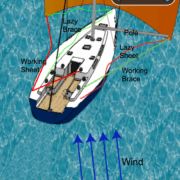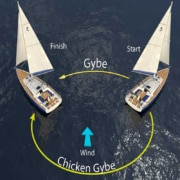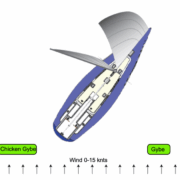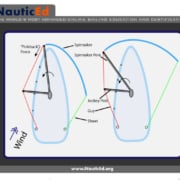How to gybe with a dipping pole
Last week we were out on a Beneteau First 45 to participate in a local regatta race series. Until now I’d been working the main and Genoa but this week I wanted to step up and run the spinnaker sheet. Not usually a problem because I’ve done it plenty of times before … but this boat uses a dipping spinnaker pole set up. Opps!
One of the guys tried to explain it to me and whoosh it all kept going over my head. I was focusing too hard on too many lines. I’m a visual learner not an auditory learner. And blindly pulling on red and green lines is not what I want to do. I want to know when and why and give it a name.
So on Tuesday, we met in a coffee shop and we drew it out enough for me to animate using HTML5 animation technology. The HTML5 animation then, shows how to gybe a sailboat that uses a dipping spinnaker pole. A spinnaker pole is longer than the distance from the mast to the forestay. Thus when gybing, dipping the pole means that the pole connection point at the mast is raised high enough so that the pole end can be swung (dipped) down and inside the forestay.
For purposes of reducing clutter on the screen, we have removed the mainsail.
Read this first so that you understand it faster and easier. Then watch the animation, then read this again. Repeat until you get it. It may take a few times but once you get it you’ll be knowledgeable enough to perform it yourself. The animation will help immensely – gybing at first is a seemingly daunting and complicated task and is almost impossible to understand with pure speech or text. Thus I make no excuses for the port – starboard – working – lazy – green – red – sheet – brace – guy text below because we back it up with a cool animation. You can’t get this kind of training on a boat because too much is happening and you can’t stop/pause it. Enjoy!
On each side of the boat, there is a Sheet (red) and a Brace (green). One Sheet and one Brace at a time on opposite sides of the boat are taught and known as “working” while the other Sheet and Brace are not taught and known as “lazy” (Scroll down now to take a sneak peek then come back here). The Brace is also known as a Guy. The Sheet is defined as the line to the spinnaker clew on the leeward (downwind) side of the boat. As you’ll see in the animation below, we start out on starboard (wind coming from the starboard side of the boat). The working Sheet and lazy Brace are on port while the working Brace and lazy Sheet are on starboard. When we gybe over the working Sheet and lazy Brace are now on starboard while the working Brace and lazy Sheet are on port. IE the lines don’t swap sides just their “working” to “lazy” status swaps.
The sole reason we do this is to be able to bring the lazy Brace forward to clip into the pole as it dips inside the forestay. In the example then, when we swing the pole down and through to port we can take up tension on this lazy Brace – now it becomes the working Brace. At this point, the port side working Sheet is no longer needed and is loosened.
Meanwhile, back on the starboard side, the old brace has been doing the work still and flying the spinnaker. We take up tension on the starboard lazy sheet so that it now becomes the working Sheet. We then release the starboard Brace so that it is loose (lazy).
During the swap over the boat is steering close to dead downwind. Thus the spinnaker is flying out front and the pole is not needed during this brief moment. The skipper has to time this right.
The advantage of the dipping pole method is that there is no lifting the pole and holding it when it is attached to the brace (guy). It is typically used on larger boats where the forces and weights are much higher.
Ultimately, what makes the task difficult to complete beautifully is that there are 7 or more people involved all doing the maneuver with all required to use exactly the right timing and some with multiple jobs. It’s a lot of people and thus everyone needs to know what to do when. Practice is paramount but equally important is a good leader. It’s the ultimate team experience.
- Bowman: Clips in the lazy brace to the pole
- Mastman: Raises the pole
- Bow assist: Swings the pole in, down and out, up. Calls topping lift and downhaul release and takeup.
- Topping lift and downhaul release and trimmer
- New Brace trimmer / old sheet release
- New Brace wincher
- New Sheet trimmer / old brace release
- New sheet wincher
- Mainsail trimmer: Hauls in mainsheet and eases out to prevent a slamming gybe.
- Skipper
Now view the animation. There is a lot going on so watch carefully and repeatedly. You’ll see the Sheets and Braces changing roles and also notice the wind direction changing relative to the boat throughout the animation. This is the role of the skipper to turn at appropriate moments.








